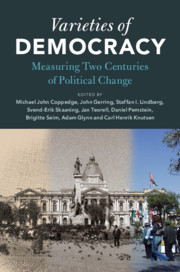Book contents
- Varieties of Democracy
- Varieties of Democracy
- Copyright page
- Contents
- Figures
- Tables
- Contributors
- Acknowledgments
- 1 Introduction
- 2 Conceptual Scheme
- 3 Data Collection
- 4 The Measurement Model and Reliability
- 5 Dimensions and Components of Democracy
- 6 Data Validation
- 7 Explanatory Analysis with Varieties of Democracy Data
- References
- Index
3 - Data Collection
Published online by Cambridge University Press: 25 January 2020
- Varieties of Democracy
- Varieties of Democracy
- Copyright page
- Contents
- Figures
- Tables
- Contributors
- Acknowledgments
- 1 Introduction
- 2 Conceptual Scheme
- 3 Data Collection
- 4 The Measurement Model and Reliability
- 5 Dimensions and Components of Democracy
- 6 Data Validation
- 7 Explanatory Analysis with Varieties of Democracy Data
- References
- Index
Summary
Users of V–Dem data should take care to understand how the data are generated because the data collection strategies have consequences for the validity, reliability, and proper interpretation of the values. Chapters 4 and 5 explain how we process the data after collecting the raw scores and how we aggregate the most specific indicators into more general indices. In this chapter we explain where the raw scores come from. We distinguish among the different types of data that V–Dem reports and describe the processes that produce each type and the infrastructure required to execute these processes.
- Type
- Chapter
- Information
- Varieties of DemocracyMeasuring Two Centuries of Political Change, pp. 43 - 65Publisher: Cambridge University PressPrint publication year: 2020



